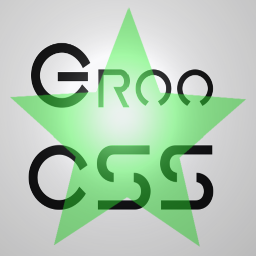fontFace {
fontFamily 'myFirstFont'
fontWeight 'normal'
src 'url(sensational.woff)'
}
GrooCSS
Code CSS in Groovy
Font-face, Media, and Custom and Detached styles
Font-face
Resolves to:
@font-face {
font-family: myFirstFont;
font-weight: normal;
src:url(sensational.woff);
}Media
media 'screen', {
body { width '100%' }
}Produces:
@media screen {
body { width: 100%; }
}Custom styles
body {
add style('-webkit-touch-callout', 'none')
add style('-webkit-textSize-adjust', 'none')
add style('-webkit-user-select', 'none')
}Resolves to:
body {
-webkit-touch-callout: none
-webkit-textSize-adjust: none
-webkit-user-select: none
}Detached Styles
You can also create Detached styles, using the styles method, which can be added conditionally to a concrete style group.
For example, see the following simple Closure definition which defines "color #123" if alpha is zero, otherwise it yields color rgba(0,0,0,alpha) which is black with the given opacity:
def mycolor = { alpha ->
styles {
if (alpha == 0) color '#123'
else color rgba(0,0,0,alpha)
}
}This would allow you to call this Closure later on within your GrooCSS multiple times with different results each time. For example:
table { add mycolor(0) }
div { add mycolor(0.5) }Would yield the following CSS:
table {
color: #123;
}
div {
color: rgba(0, 0, 0, 0.50)
}However, you’re not limited to one parameter or one style. For example, you could have a more complicated scenario like the following:
def boxedStyles = { foreColor, timing ->
styles {
transition "all $timing ease"
color shade(foreColor, 0.1)
background tint(foreColor, 0.9)
boxShadow "10px 5px 5px ${shade(foreColor)}"
}
}This would create styles which transition to a color, background, and box-shadow based on a given color. It would allow the following GrooCSS:
div.salmon %hover {
add boxedStyles(salmon, 1.s)
}And it would yield the following CSS (with default Config):
div.salmon:hover {
transition: all 1s ease;
-webkit-transition: all 1s ease;
-moz-transition: all 1s ease;
-o-transition: all 1s ease;
color: #e17366;
background: #fef2f0;
box-shadow: 10px 5px 5px #7d4039;
-webkit-box-shadow: 10px 5px 5px #7d4039;
-moz-box-shadow: 10px 5px 5px #7d4039;
}Remember, "boxedStyles" could be called multiple times, each time with different parameters. This allows code reuse so can greatly enhance your productivity.
Last updated: 31 July 2019